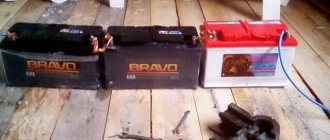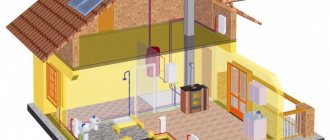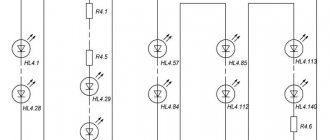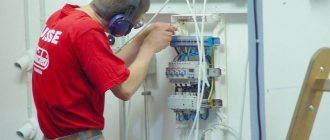Types of welding machines
To make a welding machine with your own hands, you need to delve into the essence of the issue and choose one scheme to implement your plan, and then start purchasing components.
Depending on certain parameters, it is customary to distinguish between the following types of units:
- On alternating current.
- On direct current.
- Three-phase.
- Inverter.
The first type listed in the list is considered the simplest; if you want to create a second version of the device, you need to introduce a special block and an anti-aliasing filter into the design.
Three-phase models can be found in industry; it is irrational to choose such units for home use.
Advice! The inverter type is a more complex device; without basic knowledge of board assembly and understanding of circuits, professionals do not recommend attempting to create it yourself.
Welding rectifier - features of operation and assembly
To perform certain types of welding work, for example, with stainless steel, the use of alternating current supplied by a transformer is not used. To work with such metals, a constant voltage supply is required. In addition, direct current cutting reduces the consumption of electrodes, and metal spattering is prevented during welding.
To perform work in such conditions, welding rectifiers are used, which allow welding with direct and reverse polarity current. If you have experience in installing electronic circuits, then you can also assemble such a device yourself.
The basis of the welding rectifier will be the same step-down transformer. The difference lies in the presence of a rectifying electronic circuit. If desired, you can remake the already described welding transformer or assemble a universal device that will allow you to weld with both alternating and direct current.
The simplest diagram of the electronic part of a welding rectifier looks like this:
Schematic diagram of a welding rectifier
When assembling such devices, the following design features should be taken into account:
- The main part of the device is a rectifier bridge made of powerful power diodes. They are connected according to the diagram, taking into account polarity.
- Smoothing of current ripple is carried out due to a filter made on the capacitor and choke coil. Please note that the components must have a margin of 2.5 - 3 permissible voltage.
- When working with high currents, the elements heat up. Semiconductor diodes are sensitive to overheating. Therefore, they are installed on radiators, which will increase the intensity of heat removal.
- When enclosing the device in a housing, it becomes mandatory to use a fan to increase cooling efficiency.
We pay attention to the connection of individual elements of the circuit. Considering that they will be exposed to high current, it is necessary to ensure reliable contact. If this is not done, then the wires in these areas will heat up and burn out. The preferred option is with fastening using platforms with a bolt and nut.
The choke in such designs is made in the form of a separate remote inductor, which is connected as needed. Note that installing a rectifier does not prevent the welding current from changing using the secondary winding coil position regulator.
As you can see, there are no difficulties in assembling a welding machine yourself. But it’s worth working on such devices only if you have experience in designing simple devices that operate with lower currents. Otherwise, entrust the assembly to a specialist or buy a factory welding machine.
Microwave welding machine:
List of materials and tools
When carefully familiarizing yourself with the design of a welding machine operating on alternating current, you need to know that such samples have a primary winding of 220 volts, and on the secondary winding it drops to 50-60 volts, after which it goes to the electrode in contact with the workpiece.
Before you begin assembling the equipment, you should prepare or purchase the following items:
- Magnetic core.
- Cable for coil winding.
- Materials for insulating connections.
Experts consider the factory transformer to be the most versatile workpiece; some parts are perfect for making simple models yourself. We are talking about a magnetic circuit and a primary winding, but when such components are not available, the element must be created from scratch.
Simplified welder calculation diagram
In practice, calculations are made based on the type and diameter of the electrodes used. Yes, there are more complex and accurate calculation formulas, but they are rarely used by amateurs. To obtain a stable and productive arc, it is necessary to obtain a current with the following indicators:
- For electrodes with a diameter of 2 mm, 30 - 80 A is sufficient.
- When the diameter increases to 3 mm, the current should increase to 70 - 130 A.
- For 4 mm electrodes, the value is set to 110 - 170 A.
- 5-mm electrodes are cooked at a current of 150 - 200 A.
The difference in current values is due to working with metals of different thicknesses and physical properties.
When making a welding machine yourself, you most often have to be content with a magnetic core from other devices, which is available. Therefore, the simplest calculation will be performed based on these two known characteristics - the cross-section of the magnetic circuit and the required current strength on the secondary winding.
Please note that it is preferable to use rod-type cores to assemble the transformer. Compared to armored ones, they provide a higher current density in the windings and have increased efficiency.
Types of magnetic circuits
In addition, the location of the windings on the arms of the core is also important. If the primary and secondary windings are separated into different rods, this will lead to increased magnetic dissipation due to the increased air gap. Therefore, it is considered preferable to place a part of both windings on both one and the other rod.
In this case, to determine the required number of turns of the primary winding, use the following formula:
N1 = 7440 × U1/(Sout × I2)
Where
N1 - estimated number of turns;
U1 - mains voltage (200-240V);
Siz is the cross-section of the existing magnetic circuit;
I2 is the required welding current.
Please note that for devices with spaced windings, a different formula is used:
N1 = 4960 × U1/(Sout × I2)
If you have to carry out work under conditions of unstable voltage in the network, it makes sense to calculate the number of turns for the main values - 180, 190, 200, 220 and 240 V. When winding the wires, simply make taps at these values, which will allow you to select a stable operating mode for the transformer in any conditions.
The required number of turns of the secondary winding is calculated using the following simplified formula:
N2 = 0.95 × N1 × U2/U1
Where
N1 - estimated number of turns;
U1 - mains voltage (200-240V);
U2 - required no-load voltage on the secondary winding (50 - 70 V).
Also read: How to connect a motion sensor to a light bulb
For the primary winding, choose an insulated copper wire with a cross-section in the range of 5 - 7 square meters. mm, it is enough to work with a household single-phase electrical network. When choosing, pay attention to the heat-resistant properties of the insulation; it must withstand significant heat, which cannot be avoided.
The secondary winding is wound with a thicker wire, which is associated with a significant current strength that will flow through it. The best option would be a copper bus with a cross-section of at least 30 square meters. mm.
Microwave power supply
The considered welding machine circuit after assembly should produce a minimum of 4 kW; if we take the element from a microwave oven, which has a rating of 1.2 kW, as the main part, it will not be enough.
For operation, two transformers should be selected, which will subsequently need to be connected to each other.
The detailed algorithm of actions looks like this:
- By powering two parts to a 220-volt network, the integrity of the winding is checked.
- To remove the high-voltage winding, you need to cut the magnetic core.
- The coil is removed from the chain.
- From a copper bus of 10 sq. mm the core is manufactured.
- A dielectric spacer is created under the primary winding.
- The coil and magnetic circuit are connected.
- All cables are connected in accordance with the diagram.
After installing the electrode in the holder, you can begin to check the functionality of the created unit; there is no need to take markings with a diameter of more than 4-5 mm.
DC equipment
People who professionally repair welding machines can confidently call this model more stable when considering the characteristics of the arc. An auxiliary component is responsible for the process of voltage transfer, which is known to many as a converter, supplemented by a smoothing element.
With such a device, you can weld not only the usual type of metal, but also cast iron or stainless steel, since the seam is as smooth and neat as possible.
- Before starting assembly, you will need to purchase powerful diodes or transistors in the amount of 4 pieces, each copy must have a rating of 200 A.
- The design includes a capacitor with a capacity of 15 thousand uF and a choke; when working independently, you should be guided by a special circuit.
Important! During operation of the transformer, overheating may occur, which will lead to rapid failure of the diodes; to prevent this excess, the structure is equipped with a device for heat removal.
Diagnostics of a homemade inverter and its preparation for operation
Making an inverter welding machine is half the battle. An equally important task is its preparation for work, during which the correct functioning of all elements is checked, as well as their settings.
The first thing you need to do when checking a homemade welding inverter is to apply a voltage of 15 V to the PWM controller and one of the cooling fans. This will allow you to simultaneously check the functionality of the controller and avoid overheating during such a test.
Checking the output voltage with a tester
After the capacitors of the device are charged, a relay is connected to the electrical supply, which is responsible for closing the resistor. If you apply voltage directly to the resistor, bypassing the relay, an explosion may occur. After the relay operates, which should happen within 2-10 seconds after applying voltage to the PWM controller, you need to check whether the resistor has shorted.
When the relays of the electronic circuit operate, rectangular pulses should be generated on the PWM board and supplied to the optocouplers. This can be checked using an oscilloscope. The correct assembly of the diode bridge of the device also needs to be checked; for this, a voltage of 15 V is applied to it (the current should not exceed 100 mA).
The transformer phases may have been incorrectly connected when assembling the device, which can lead to incorrect operation of the inverter and the generation of strong noise. To prevent this from happening, the correct phase connection must be checked using a dual-beam oscilloscope. One beam of the device is connected to the primary winding, the second to the secondary. The phases of the pulses, if the windings are connected correctly, should be the same.
Using an oscilloscope to diagnose an inverter
The correct manufacturing and connection of the transformer is checked using an oscilloscope and connecting electrical devices with different resistances to the diode bridge. Based on the noise of the transformer and the readings of the oscilloscope, they conclude that it is necessary to improve the electronic circuit of the homemade inverter apparatus.
To check how long you can continuously work on a homemade inverter, you need to start testing it from 10 seconds. If the device’s radiators do not heat up during operation for such a duration, you can increase the period to 20 seconds. If such a time period does not negatively affect the condition of the inverter, you can increase the operating time of the welding machine to 1 minute.
Unit with small dimensions
A well-assembled inverter welding machine is no less useful both in production and at home when repairing cars or small items.
Thanks to this type of device, it is possible to implement spot welding, which in some situations will be much more convenient, besides, the weight and dimensions of the box are quite compact, it can be easily carried by hanging it on your shoulder.
The design includes:
- Diode rectifier.
- Management system.
- Power part.
- Diode and choke.
- Cooler for cooling.
- Feedback to control parameters.
When creating a model, you will need to wind a power transformer yourself, the base of which will be a ferrite ring. Professionals advise purchasing a ready-made assembly of semiconductor elements for the bridge; some components cannot be found at home; they are often ordered or bought in specialized stores.
The device is considered quite complex; without self-confidence, suitable circuits and basic skills, you should not undertake the process.
Having started to implement their plans, many owners noticed that independently constructing an inverter model is no cheaper than factory products, so it is most rational to buy a ready-made unit with specified operating parameters.
Video instructions will be no less practical; thanks to them, you will be able to understand all the stages of work on creating equipment much faster.
Possible details when creating a welding machine
Welding rectifier circuit.
When creating a welding machine with your own hands, the stability of the electric arc is achieved by constant potential. The stability of the arc ensures the quality of the resulting seams. Constant potential is achieved by using high-power rectifiers, which are carried out on diodes that can withstand currents of up to 200 A, such as, for example, the B-200.
These diodes are large in size and require mandatory use to organize high-quality heat removal from massive radiators. This circumstance must be taken into account when manufacturing the structure body. The best option when creating a design would be to use a special diode bridge. The diodes can be mounted in parallel, which significantly increases the output current.
When assembling a structure with your own hands, you need to adjust all its components. If the selection is poor or incorrectly calculated, the design can affect the quality of welding.
Sometimes, with the appropriate selection of parts and components, a truly unique device can be obtained, which has a soft and easy ignition of the electric arc, and parts can be welded even with very thin walls, with almost no splashing of liquid metal.











